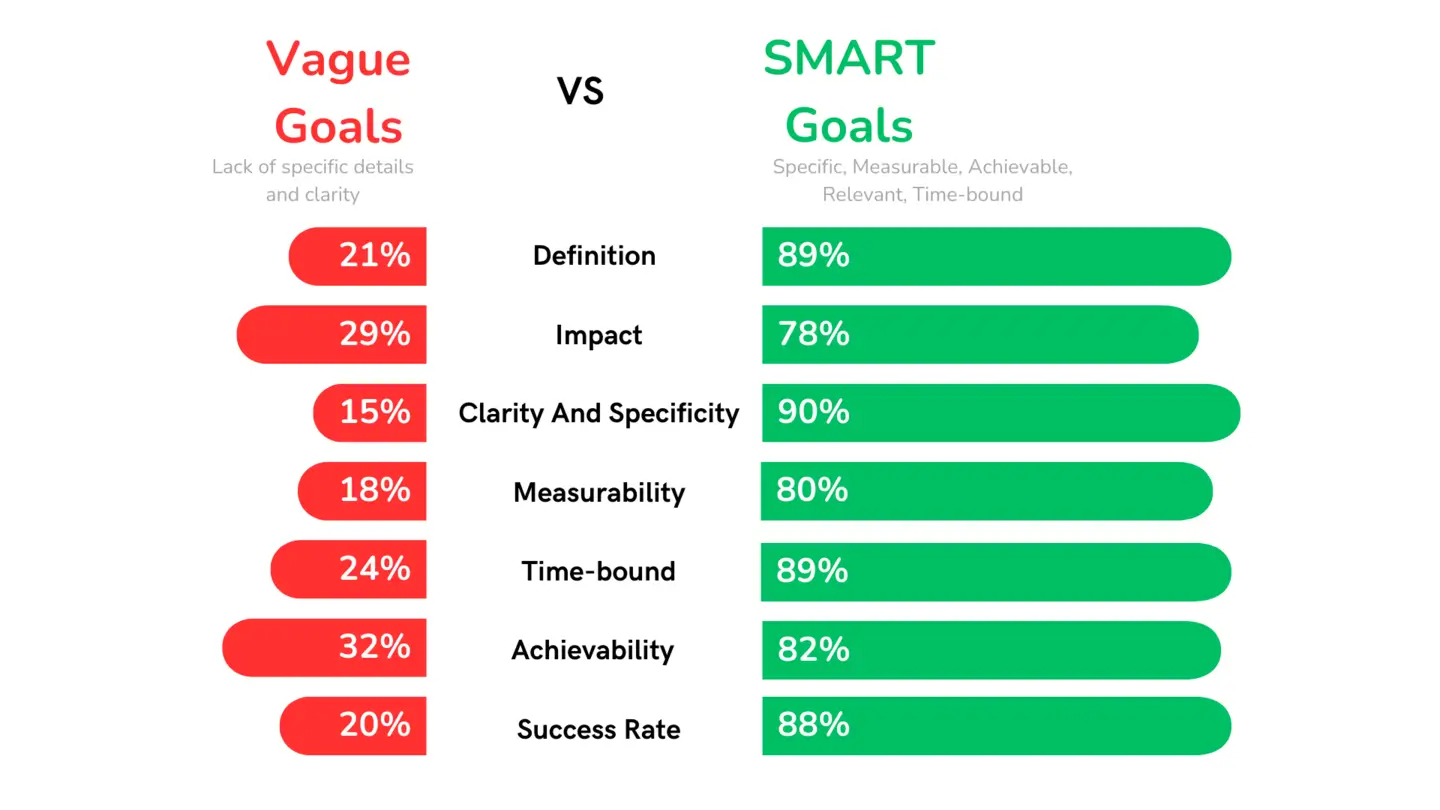Ever feel like you’re working hard, but not making the kind of progress you want in life? Chances are, you might be setting vague goals without even realizing it.
Vague goals sound like this: “I want to get in shape” or “I want to be more organized”. They lack direction, making it hard to know where to start or how to measure success.
The solution is ditching vague goals for the power of a different approach. It’s time to discover a goal-setting system designed for clarity, action, and actual results.
"The trouble with not having a goal is that you can spend your life running up and down the field and never score."
 Bill Copeland
Bill Copeland Understanding Vague Goals
Vague goals are the invisible roadblocks that sabotage your progress before you even start. They’re the ambiguous, ill-defined objectives that leave you feeling confused and demotivated.
Without a clear target to aim for, you’ll find yourself spinning your wheels, unsure of which direction to go. To conquer vague goals, we must first understand what they are and how they hold you back.

What they are?
Vague goals are aspirations that lack specificity and clarity, making them difficult to achieve because they don’t provide a clear path to follow.
- ”I want to get in shape” - This vague goal gives no specifics about what “in shape” means or how to achieve it. Does it refer to building muscle, losing weight, increasing endurance?
- ”I want to be more productive” - While admirable, this offers no clarity on what productivity looks like or what areas need improving - time management, eliminating distractions, better habits?
- ”I want to earn more money” - A common vague aspiration with no target income, timeline, or strategy outlined for increasing earnings.
These goals are akin to saying, “I want to travel” without choosing a destination, planning the route, or deciding what to pack.
They are broad and undefined, leaving too much room for interpretation and making it challenging to measure progress or completion.
Vague Goals Produce Vague Results
Vague goals share common traits that make them easy to identify and crucial to avoid.
Lack of Specificity
The biggest issue with vague goals is their lack of clear, specific details. Statements like “I want to lose weight” or “I want a new job” don’t provide any concrete guidance on what needs to be achieved or how to get there.
Immeasurability
Since vague goals are unclear, there’s no way to quantify progress or determine when you’ve actually accomplished the goal. Without benchmarks or metrics, you’ll constantly be wondering if you’re making any headway.
Absence of Timelines
Most vague goals neglect to include a target date or timeline to work towards. Open-ended goals allow you to perpetually procrastinate and push them off indefinitely.
Unrealistic Expectations
Broadly stated goals tend to be overly idealistic or ambitious without accounting for limitations or realistic parameters. This sets you up for disappointment.
Lack of Accountability
When goals are imprecise, it’s easy to make endless excuses and justifications for a lack of progress. There’s nothing concrete to hold you accountable.
"Setting goals is the first step in turning the invisible into the visible."
 Tony Robbins
Tony Robbins If you don’t intentionally define what success looks like, you’ll inevitably accept unsatisfactory results. Vague goals produce vague, lackluster outcomes. Ditch them in favor of clarity and precision.
Vague Goals vs SMART Goals
Forget the uncertainty of vague goals. It’s time to discover a proven framework specifically designed for success: the SMART goal system.
Let’s explore what makes SMART goals so powerful and how they provide the roadmap you need to achieve your dreams.

Definition and Impact
Now that we understand the pitfalls of vague goals, let’s look at the power of SMART goals. This simple framework will change everything about how you approach goals.
| Aspect | Vague Goals | SMART Goals |
|---|---|---|
| Definition | Lack specific details, making them broad and open to interpretation. | Specific, Measurable, Achievable, Relevant, and Time-bound, providing clear direction. |
| Impact | Lead to confusion and procrastination due to lack of clarity and direction. | Facilitate focused action and decision-making, leading to more consistent and achievable results. |
Clarity and Specificity
One of the core problems with vague goals is their blatant lack of clarity and specificity. There’s no detail around what exactly needs to be accomplished or how you’ll get there.
In contrast, SMART goals eliminate ambiguity by defining precise targets and deliverables. Rather than a subjective statement like “get fit”, an effective goal specifies quantifiable factors like an exact weight loss target, body composition metrics, and a clear timeline.
- Vague Goals: “I want to get fit”
- SMART Goals: “I will lose 20 pounds by building muscle and reducing my body fat percentage from 25% to 18% over the next 6 months”
This granular level of detail prevents any guesswork about what “success” looks like. You know precisely what you’re working towards at every step. The goal creates a vivid mental image you can visualize and measure progress against.
"A goal properly set is halfway reached."
 Zig Ziglar
Zig Ziglar Measurability and Accountability
A major drawback of vague goals is their immeasurability. It’s impossible to know if you’re “making more money” or have achieved any tangible results.
SMART goals have baked-in measurements and key performance indicators. You can objectively verify whether you hit the target or not.
- Vague Goal: “I want to make more money”
- SMART Goal: “I will increase my monthly income by $3,000 through freelance writing jobs within the next 12 months”
This measurability provides vital feedback loops and accountability. With numbers to monitor, you can clearly see what’s working or not. You’re able to make adjustments and optimizations along the way based on real data.
Time-Bound Structure
Another key advantage of SMART goals is that they are expressly time-bound with a defined start and end date. This deadline-driven structure provides urgency, focus and prioritization.
This deadline-driven structure also eliminates procrastination and makes optimal use of motivation waves. You’re able to fully capitalize on high motivation periods toward achieving the goal by a set date.
Without a timeline, vague goals have no impetus for execution. It’s easy to continually delay taking action when there’s no target date looming. Time-bound goals create pressure to make consistent progress.
- Vague Goal: “I want to read more books”
- SMART Goal: “I will read 24 books (2 per month) over the next 12 months”
"Goals are dreams with deadlines"
 Diana Scharf Hunt
Diana Scharf Hunt Achievability and Realism
While it’s admirable to dream big, vague goals often suffer from a lack of achievability and realism. In the back of your mind, you may doubt whether such an idealistic aim is truly attainable given your current circumstances.
SMART goals emphasize achievability - ensuring the objectives are realistic and based on your resources, abilities, and constraints.
- Vague Goal: “I want to become a millionaire”
- SMART Goal: “I will increase my net worth by $100,000 over the next 2 years through investing and side business income”
By setting ambitious yet achievable goals, you strike the perfect balance of keeping yourself motivated while still defining a finish line within reasonable reach. Unattainable goals become demoralizing over time.
Outcome and Success Rate
At the end of the day, the proof is in the pudding when it comes to evaluating the effectiveness of goal-setting methods. And the data is crystal clear - SMART goals produce vastly superior outcomes compared to vague, ambiguous targets.
Numerous research studies highlight the impact of well-defined goals on motivation levels, effort expenditure, persistence, and overall achievement rates:
- A study by the Dominican University found that students with specific, difficult goals persisted 63% longer than peers with vague goals.
- Harvard Business School Study revealed that only 3% of graduates had written goals, but this 3% earned higher incomes than the other 97% combined.
The evidence is overwhelming - individuals who establish SMART goals experience higher success rates across all facets of life from work, education, health, finance, and beyond.

Transform Your Vague Goals into SMART
Now that you understand the vast advantages of SMART goals over vague ones, it’s time to learn how to transform your own ambiguous objectives into well-defined, actionable targets.
To illustrate each step, we’ll follow a case study example of a person named Alex.
Alex is a 32-year-old marketing manager who has long had the vague goal of “improve overall wellbeing”.
1. Specify Your Goal
The first essential step in transforming a vague goal into a SMART one is to get hyper-specific about what you truly want to achieve. Broad statements lack the necessary detail to formulate an actionable plan.
- Define the exact outcome or result you desire
- Outline all relevant factors, numbers, skills, habits etc.
- Remove any ambiguous or subjective language
"You must be specific about what you want to achieve. Vagueness breeds confusion, and clarity is the key to achieving your dreams."
 Crystal Paine
Crystal Paine ALEX CASE STUDY
Alex’s Goal Specified: “I want to increase my energy levels, reduce my body fat percentage from 28% to 20%, build more muscle definition, and establish consistent sleep/nutrition habits over the next 6 months.”
By specifying the details, Alex has clarity on the key areas he aims to improve:
- More energy
- Lower body fat from 28% to 20%
- Build muscle definition
- Develop habits around sleep and nutrition
- 6 month timeline
This level of specificity eliminates any ambiguity about what “improved wellbeing” actually looks like for Alex. He now has a vivid, multi-dimensional picture of success to visualize and work toward.
2. Make It Measurable
Once you’ve clearly defined your goal, the next step is ensuring it has measurable components to track progress and confirm when you’ve achieved success.
Immeasurable goals provide no way to validate completion or make adjustments along the way.
- Identify the key metrics or numbers you’ll quantify
- Establish concrete data points to gauge your advancement
- Set specific benchmarks to hit at regular intervals
ALEX CASE STUDY
Measurable Targets:
- Morning energy levels rated 1-10
- Body fat % measured by calipers
- Muscle mass/definition tracked by body circumference measurements
- Sleep tracked by wearable device, aiming for 7-8 hours per night
- Nutrition tracked by calorie/macro counting app, hitting set targets
With defined benchmarks, Alex receives constant feedback on what’s working versus not. He can adjust his diet, workout routine, bedtime habits etc accordingly until all the measures align with his goal’s metrics for success.

3. Ensure It’s Achievable
No matter how specific and measurable your goal may be, it won’t be effective if it’s not realistically achievable based on your current circumstances. Overambitious aims usually lead to burnout, frustration, and failure.
- Assess your resources, skills, schedule, and limitations honestly
- Set a “stretch” target that pushes you, but isn’t impractical
- Build in buffer room and have contingency plans
ALEX CASE STUDY
Original Measurable Goal:
- Reduce body fat from 28% to 20%
- Build muscle definition
- Consistent 7-9 hours sleep
- Strict nutrition targets
- Works 60 hours/week at demanding job
- Limited time to exercise
- Lives alone, struggles with meal prep
- Chronic poor sleep from stress/anxiety
- Reduce body fat to 22-24% (more realistic than 28%)
- Aim for 3 resistance training sessions per week
- Sleep target of 6-7 hours per night to start
- Simple nutrition plan focused on whole foods
By analyzing his lifestyle, Alex realized his original aims like a 20% body fat percentage were too lofty with his 60-hour work schedule and lack of time.
The adjusted goals are still challenging, but factor in his constraints.
"A dream becomes a goal when action is taken toward its achievement"
 Bo Bennett
Bo Bennett 4. Be Relevant
Even a specific, measurable, and achievable goal can fall flat if it’s not genuinely relevant and meaningful to you. Superficial aims you don’t have an emotional investment in will inevitably lead to waning motivation.
- Align it with your core values, interests and bigger life vision
- Understand the “why” behind wanting to achieve it
- Envision how success will positively impact your life
Research discovered that 90% of people perform better with relevant and challenging goals. (Source: APA PsycNet)
ALEX CASE STUDY
Relevance Affirmation:
“By regaining my energy, getting fit, and establishing health-promoting habits, I’ll be able to maximize my productivity and performance at work. I’ll have more confidence putting myself out there socially and dating. Most importantly, getting in great mental and physical shape now sets me up to live an active lifestyle and be the best uncle I can be as my family grows.”
Clearly defined relevance gives Alex’s health goal deeper meaning beyond just the numbers.
5. Time-Bound It
The final crucial step in making your goal SMART is adding a time-bound element with a realistic yet firm deadline. Open-ended objectives provide zero urgency or accountability to spur you into action.
- Set a specific end date to achieve it by
- Create periodic milestones or check-in dates
- Build in a schedule or routine to follow
ALEX CASE STUDY
Time-Bound Structure
- 6 month timeline from May 1 to October 31 to achieve main goals
- Check-ins every 4 weeks to gauge progress
- Set workout days as M/W/F evenings
By bookending his goal with a 6-month timeline from May through October, Alex has created a motivating sense of urgency. He can’t keep kicking the can on improving his health.
Finally, scheduling set workout days builds exercise into his weekly routine, rather than leaving it up to chance and motivation waves.
Bonus Step: SMART Goal Generator
Here is a little help that will help you to create your SMART Goal. You can use it to transform your Vague goal into a SMART one.
Free SMART Goal Generator!
Final Thoughts
Ditching vague goals and embracing the SMART framework is one of the most powerful choices you can make for achieving your dreams.
It’s the difference between wandering aimlessly and following a proven roadmap to success. As you’ve seen with Alex’s journey, this process brings clarity, focus, and a deep sense of purpose to every goal you pursue.
Next Steps
- Reflect: Take some time to think about areas of your life where you’ve felt held back by vague goals.
- Choose: Select one goal that you’re ready to transform using the SMART framework.
- Start Small: Don’t try to overhaul everything at once. Focus on making one goal exceptionally clear and achievable.
- Celebrate: Acknowledge each step toward your SMART goal, no matter how small.
"Goal setting is the secret to a compelling future."
 Tony Robbins
Tony Robbins Frequently Asked Questions
How can I tell if my goal is too vague?
Ask yourself these questions: Can I easily visualize what success looks like? Is there a way I can track my progress? Does it have a clear deadline or timeframe?
If you answer “no” to any of these questions, it’s likely your goal needs more specificity.
Can I have more than one SMART goal at a time?
Absolutely! In fact, it’s often beneficial to have several SMART goals across different areas of your life. The key is to prioritize, making sure your focus isn’t scattered too thinly and that your goals don’t conflict.
How can I stay motivated when pursuing my SMART goals?
Focus on the “why” behind your goal – the positive impact it will have on your life. Break your goal into smaller milestones to celebrate along the way.
Find an accountability partner or join a supportive online community for extra encouragement during challenging moments.
Why do people settle for vague goals?
There are a few common reasons: Fear of failure makes vague goals feel safer because they’re harder to definitively fail at. Many people simply aren’t aware of systems like SMART for setting clearer goals.
Sometimes, the sheer scale of our aspirations can make specificity feel too daunting. Understanding the reasons behind vague goals can help you break the cycle and start setting yourself up for success!




